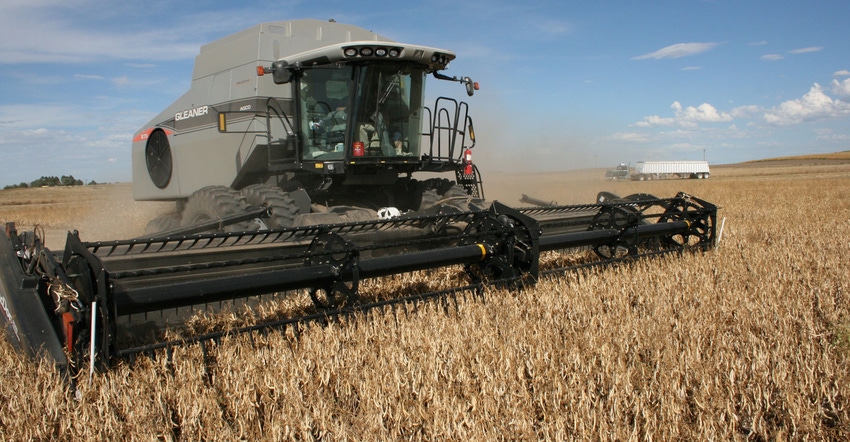
Nebraska Panhandle crops have witnessed another season of extremes. While some yields were outstanding, hail damaged several areas, and wet weather during dry edible bean harvest had some farmers at a standstill for two to three weeks.
Northern Panhandle Nebraska Crops Extension educator John Thomas, Alliance, says that rain events caused problems for many dry bean growers. Traditional dry bean harvest includes undercutting and windrowing dry beans to dry out before combining. Several growers in Box Butte County, in particular, have been trying direct-harvest methods with a flex-draper combine header, bypassing the traditional windrowing, Thomas says.
During the rain events, these growers were often able to get back into the field more quickly. “This year, there were farmers who had beans laying in the windrow for two to three weeks because of rain. Sometimes windrowed beans get blown around,” Thomas says. “Beans can get discolored in the windrow from rain and lose quality grade.”
Planning needed
However, Thomas warns that management for direct harvest of dry beans starts at planting time. “You have to plan to direct-harvest,” says Thomas. “It starts with choosing the correct variety to plant and planting into a level field surface. Then, you must follow up with a good weed management program,” he notes. “It’s more than just slapping a different header on the combine. It is a totally different strategy.”
According to Thomas, over the last five years, the number of dry bean growers who are direct-harvesting has grown from about 5% to nearly 20%. “I think it will keep going in that direction,” he adds.
“Some fields this year were standing nicely, with minimal harvest losses, but some fields saw stem damage due to hail,” Thomas says. “That’s why we saw harvest losses from 1 to 1.5 bushels per acre all the way up to 8 bushels per acre.”
He notes that normal harvest losses for dry edible beans that are windrowed would be in the range of 1 to 1.5 bushels per acre. Growers who are direct-harvesting might experience harvest losses of 2 to 2.5 bushels per acre on pinto beans and 3 to 3.5 bushels per acre on great northern beans under normal harvest conditions.
“In Box Butte County, we had a pretty average year, but we also had some severe hail,” says Thomas. “Some of my dry bean study plots north of Alliance were zeroed out on yield. We had other fields that had reduced yields on beans. Hail also can cause disease issues. Beans that are injured by hail may not dry down properly.”
But Thomas reported some exceptional yields as well, in the range of 60 to 65 bushels per acre. On average, yields were about 40 to 45 bushels per acre, he says.
Gary Stone, Nebraska Extension educator at Scottsbluff, also reports some exceptional bean yields, but he notes that average yields in his area were between 50 and 60 bushels per acre. Last year, bean yields ranged from about 35 to 50 bushels per acre, Stone says.
Yields in the western portions of the state have been reasonably good on all crops. Stone estimates corn yields in his area to be between 80 and 100 bushels per acre on dryland and 160 and 220 bushels per acre on irrigated. Stone says that corn in 2016 in his area ranged a little less at about 60 to 80 bushels per acre on dryland, and 145 to 205 bushels per acre on irrigated corn.
Sugarbeet stats
Sugarbeet production was forecasted in the USDA National Agriculture Statistics Service report for the week ending Nov. 5 to be 1.44 million tons, up 2% from 2016. The area harvested this season in Nebraska was 44,600 acres, down 6%. Yield was being forecast at 32.3 tons per acre, which would be 2.4 tons per acre up from 2016. Stone was estimating yields on sugarbeets in his area within that range, between 30 and 35 tons per acre with 15% to 17% sugar on average. He says yields in 2016 ranged from 28 to 34 tons per acre and 14% to 16% sugar.
Sugarbeet yields were also very good in Thomas’ area, he says. “In our area, a lot of the beet growers were looking at a record crop early on,” Thomas says. “But hail hit some fields. Yields were still very good, ranging between 28 and 32 tons per acre, with sugar content averaging 17.5%.”
Field peas, sunflowers and millet
Field peas yielded between 25 and 35 bushels per acre on dryland this year in western Nebraska, with irrigated field peas at 60 to 70 bushels per acre, according to Stone. Last year in Stone’s area, dryland field peas yielded slightly less at 20 to 30 bushels per acre, with irrigated yields also less at 50 to 60 bushels per acre.
Dryland oil sunflowers in the Panhandle were yielding 1,500 pounds per acre on average, Stone says. That’s up from last year’s average in Stone’s area of about 1,250 pounds per acre.
Proso millet yields were in the 35 bushels per acre range this year, compared to about 30 bushels per acre last season, he says.
Learn more by contacting Stone at 308-632-1230 or Thomas at 308-762-5616.
About the Author(s)
You May Also Like






